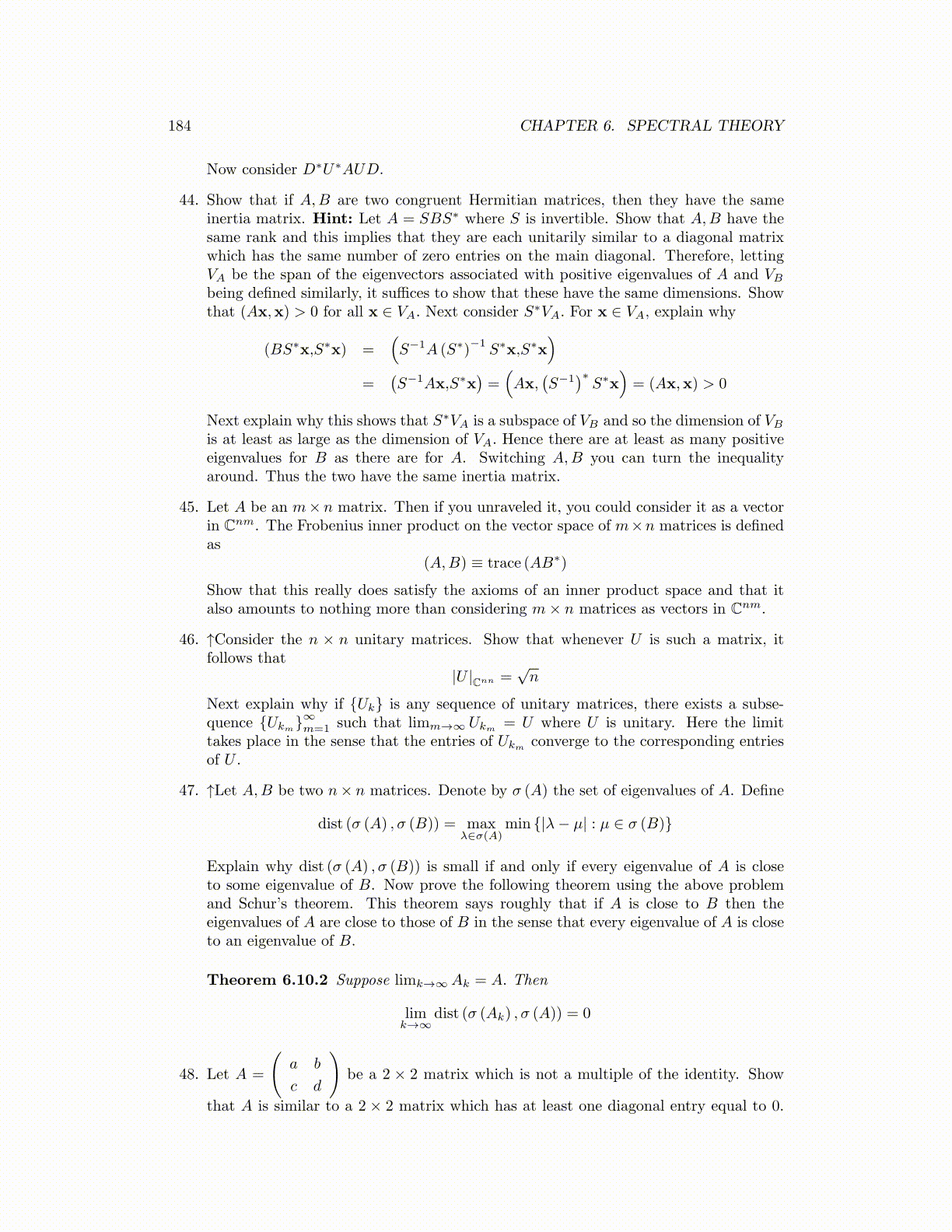
184 CHAPTER 6. SPECTRAL THEORY
Now consider D∗U∗AUD.
44. Show that if A,B are two congruent Hermitian matrices, then they have the sameinertia matrix. Hint: Let A = SBS∗ where S is invertible. Show that A,B have thesame rank and this implies that they are each unitarily similar to a diagonal matrixwhich has the same number of zero entries on the main diagonal. Therefore, lettingVA be the span of the eigenvectors associated with positive eigenvalues of A and VBbeing defined similarly, it suffices to show that these have the same dimensions. Showthat (Ax,x) > 0 for all x ∈ VA. Next consider S∗VA. For x ∈ VA, explain why
(BS∗x,S∗x) =(S−1A (S∗)
−1S∗x,S∗x
)=
(S−1Ax,S∗x
)=(Ax,
(S−1
)∗S∗x
)= (Ax,x) > 0
Next explain why this shows that S∗VA is a subspace of VB and so the dimension of VBis at least as large as the dimension of VA. Hence there are at least as many positiveeigenvalues for B as there are for A. Switching A,B you can turn the inequalityaround. Thus the two have the same inertia matrix.
45. Let A be an m×n matrix. Then if you unraveled it, you could consider it as a vectorin Cnm. The Frobenius inner product on the vector space of m×n matrices is definedas
(A,B) ≡ trace (AB∗)
Show that this really does satisfy the axioms of an inner product space and that italso amounts to nothing more than considering m× n matrices as vectors in Cnm.
46. ↑Consider the n × n unitary matrices. Show that whenever U is such a matrix, itfollows that
|U |Cnn =√n
Next explain why if {Uk} is any sequence of unitary matrices, there exists a subse-quence {Ukm
}∞m=1 such that limm→∞ Ukm= U where U is unitary. Here the limit
takes place in the sense that the entries of Ukmconverge to the corresponding entries
of U .
47. ↑Let A,B be two n× n matrices. Denote by σ (A) the set of eigenvalues of A. Define
dist (σ (A) , σ (B)) = maxλ∈σ(A)
min {|λ− µ| : µ ∈ σ (B)}
Explain why dist (σ (A) , σ (B)) is small if and only if every eigenvalue of A is closeto some eigenvalue of B. Now prove the following theorem using the above problemand Schur’s theorem. This theorem says roughly that if A is close to B then theeigenvalues of A are close to those of B in the sense that every eigenvalue of A is closeto an eigenvalue of B.
Theorem 6.10.2 Suppose limk→∞Ak = A. Then
limk→∞
dist (σ (Ak) , σ (A)) = 0
48. Let A =
(a b
c d
)be a 2 × 2 matrix which is not a multiple of the identity. Show
that A is similar to a 2 × 2 matrix which has at least one diagonal entry equal to 0.